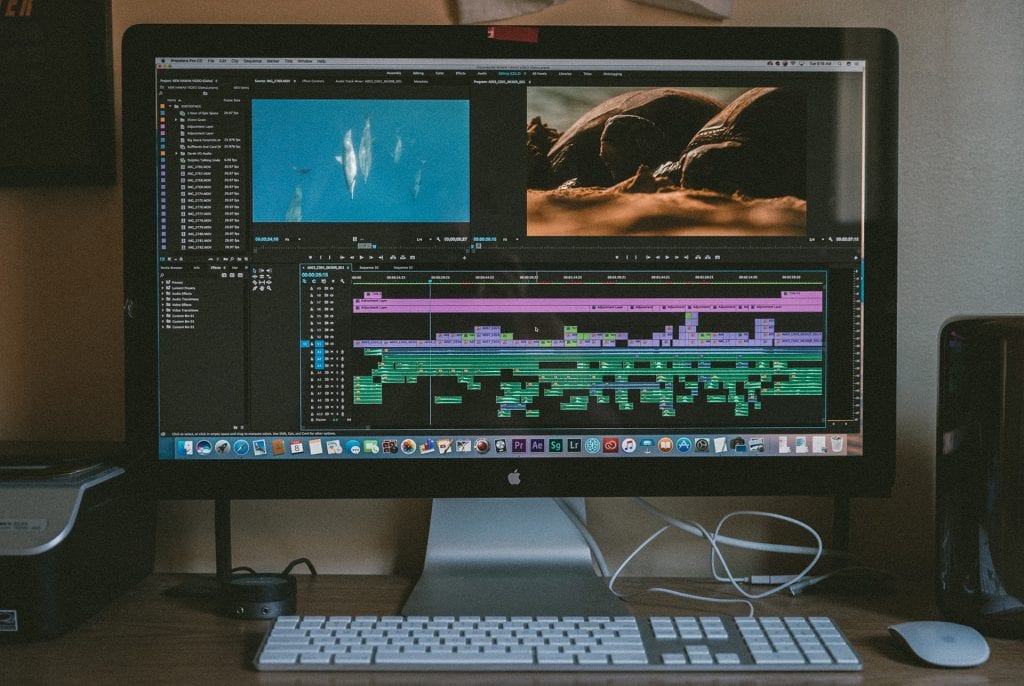The difference between Lightroom and Photoshop
In the world of photo manipulation, it seems like there are countless applications that are designed to help photographers get their desired effects. It can be hard to navigate through all the options—especially as many of them require a monthly fee to be operated—and discover which programs are most suited to your particular photo editing needs.
The following will explore two of the more popular photo manipulation applications, both of which are part of the Adobe Creative Cloud—Lightroom and Photoshop. Depending on what you are trying to do with your photographs, one of these programs might be exactly what you’re looking for.

The commonalities
Before we begin, it is essential to note that there are many features the two programs have in common. For example, they both allow you to work in a way that doesn’t alter your original image if you don’t want to, and both are now using Adobe’s AI and machine learning tools called Sensei. This being said, each program was designed to help artists accomplish different aims when it comes to images. In the broadest sense, Lightroom is a tool designed to help you manage and process hundreds, if not thousands, of photos. Photoshop is designed to offer greater control and more in-depth edits. It is completely possible that you’ll end up using both programs for the best results in your situation.
Lightroom is focused on photographers
Photoshop is designed to handle a wider variety of projects than Lightroom. Lightroom was built for professional photographers in particular, with the workflow of a photographer in mind. When it comes to Lightroom, there are two different options: Lightroom and Adobe Photoshop Lightroom Classic. You can read more here if you’re having trouble understanding the differences between the two. Your choice will depend heavily on the number of devices you regularly edit images on.
Lightroom is great for organising massive quantities of images
One of the big draws towards Lightroom for a lot of photographers is how smoothly it handles large amounts of photos. Lightroom is stellar at helping artists process larger quantities of pictures and get the work done more quickly. It has a library-esque catalogue that allows you to store, organize, and rate photos within albums and collections. It also has a keyword search option to help you find that one photo out of a thousand.
Lightroom is fantastic for editing photos
Altering the colour and making other enhancements to light, perspective, and sharpness is what Lightroom was designed for. It also allows you to save edit presets so you can apply the same alterations to a large number of photos all at once. You also have the option of purchasing Lightroom presets from photographers you admire in order to mimic their photo editing techniques. Lightroom can also help you make minor alterations like reducing red-eye, softening the look of skin blemishes, and whitening teeth.
Photoshop is focused on photo manipulation
When it comes to having complete control over an image and unlimited possibilities for alterations, Photoshop is the program for you. Inside Photoshop, you’ll be able to take an image and turn it into something else completely. Cinemagraphs and other trendy effects are often accomplished with Photoshop. You’re able to cut out objects within a photo or make a composite of several images. You have great flexibility when it comes to graphic design and illustrations.
Photoshop allows you to work in layers
Layers allow you to make multiple copies of an image and stack them on top of each other. You can designate one layer for colouring, one for white balance, one for the background edits, one for the foreground, etc. Because of the layer feature, you’re able to tweak each individual part of the image exactly as you’d like to without influencing the rest of the image.

Hopefully, the above information has opened your eyes to which photo editing software is best for your current projects. If you intend on working with massive quantities of images without drastically altering the photos themselves (just tweaking colour, brightness, sharpness, clarity, etc.), then Lightroom is probably right for you. Suppose you want to drastically alter an image (let’s say, making your cat appear larger than Nicolas Cage with several other images blended together in the background). In that case, Photoshop is probably right for you.
It is worth noting that both of these programs allow for a one-week free trial, so if you’re still unsure which one suits your workflow best, feel free to try them both out. It is also worth mentioning that Lightroom tends to be a little easier to pick up for beginners as working with layers like in Photoshop requires an alteration in how you think about images.
![[AD] We went to the newly opened Cha Sha Kingston a couple of weeks ago, and wow — taste bud adventure unlocked! The boys devoured the masala fries and chicken tikka rolls, while we couldn’t get enough of that epic kebab butter curry 😍🍛.
It’s amazing value for food this tasty (and everyone left happy and VERY full!).
Delicious food, vibrant vibes and incredible value — the perfect combo for your next meal.
📍Cha Sha Kingston
43 Surbiton Road, KT1 2HG
🌐 chasha.co.uk
Other Cha Sha locations in Birmingham, Ilford, Southampton and Wembkey
#ChaSha #ChaShaKingston #KingstonEats #FoodieFinds #UKFoodie #FoodReview #KingstonUponThames #FamilyEats #FamilyDining #FoodieKids](https://suburban-mum.com/wp-content/uploads/2016/02/574770541_18560351146016840_6855048070839528040_n-180x320.jpg)

![[AD] We’re a cricket-mad family, so we’re buzzing that @thehundred is back this August! 🏏🔥
To get ready, M tried out the official FREE Activity Pack — and it’s brilliant! 🙌
Packed with fun games, creative challenges and sporty tasks, it’s perfect for getting kids hyped whether you’re at home or on the go.
👉Download yours now (link in bio)
@londonspirit @ovalinvincibles #EveryMomentCounts #TheHundred
#EnglandCricket #CricketFamily #TheHundredCricket #LondonBloggers #Cricket #CricketIsLife #kidsfun](https://suburban-mum.com/wp-content/uploads/2022/11/505472555_18531279601016840_7092520074819907569_n-180x320.jpg)



![[AD - Press visit]
We enjoyed the glorious sunshine this weekend with a trip to Brighton. We went on the @brightoni360official which is right by the sea front.
The i360 pod take a slow journey up, allowing you to take in views across Brighton and the South Downs 450ft above ground. There’s a bar inside with drinks and snacks available to purchase and the experience lasts 25 minutes.
Afterwards, we headed to the open air roller rink for a roller skating session!
The roller rink is:
⭐ Suitable for over 5s
⭐ £6.50 if you have your own skates or £9.50 if you need to hire them
⭐ 45 minutes per session
Full details to visit the i360 + skating
📍 Brighton i360, Lower Kings Road, Brighton BN1 2LN
🚗 Parking nearby (we parked in the Regency Square Car park)
🎟️ Prices start from £25.40 for an adult and £16.90 for a child
🕐 Opening hours are currently Sun-Fri 10.30am-18.30pm and until 19.30pm on Saturdays
☕️ Bar inside the i360, cafe and gift shop
Book tickets here:
https://tickets.brightoni360.co.uk/tickets/?_ga=2.195305772.1869001490.1689671753-1757164059.1689671753/#events?eventid=157](https://suburban-mum.com/wp-content/uploads/2015/04/417980235_313576471048632_3682382982231216432_n.jpg)

![[AD] ***Summer of fun at Barracudas Activity Camps!****
There is plenty for kids to do at @barracudas_activity_day_camps
From Tennis, Archery, Swimming, Motor Sports and more you can be sure that there will be something for kids aged 4.5-14. ⚽🏈🥅🎾🏓🏎️🏹🏊♂️🏉
You can book on a day by day basis - so it can fit in with any other days out/activities you have planned and there are early drop off and late pickup options available. Barracudas are also Ofsted registered so you can use your Childcare Vouchers too.
⭐⭐⭐Get £20 off a week or £4 off a day using my discount code: MARIA20⭐⭐⭐
#BarracudasActivityDayCamp #BarracudasActivityCamp #BarracudaAmbassadors #SummerHolidays #SchoolHolidays #Summer2023 #SummerCamp #DayCare #Camp #KidsCamp #surreymummy #surreymums #SummerOfFun #ActivityCamps #HolidayCamps #Childcare #SchoolHolidays #schoolholidaycamps](https://suburban-mum.com/wp-content/uploads/2024/07/353583570_625625966167953_545896259645102575_n.jpg)



![[AD] We have some super exciting news...we have been chosen to be Laser Quest Ambassadors, and the boys are over the moon!
We are really lucky that our local Laser Quest (@laserquestkingston) is just around the corner from us. It means we can pop in of a weekend or anytime during the school holidays, and with summer just around the corner, I know Laser Quest will be one of our go-to places for some family fun.
As well as games of Laser Quest, there are also VR experiences and arcade amusements too. To find out a bit more about how Laser Quest works, you can read my blog post: https://www.suburban-mum.com/laser-quest-kingston/ (clickable link in bio)
Don't forget to keep an eye out for our Laser Quest posts - I'm going to be giving away two family passes to use at Laserquest Kingston!
If you can't wait and want to head down to Laser Quest to try it out, use the code SUMMER30 for 30% off your booking. The code is valid from now until the end of August 2023 and can be used on Laser Quest games and birthday party bookings.
#LaserquestAmbassador #Laserquest #LaserquestKingston #ActivitiesForKids #FamilyFun #DaysOutWithKids #Lasertag #LaserquestVR #Kingston #ThingsToDoInKingston #SurreyFamilyDaysOut #ThingsToDoWithKids #RainyDayFun #SurreyMummy #SurreyLife #LifeWithKids #LifeWithBoys #familyfunday](https://suburban-mum.com/wp-content/uploads/2015/04/353230107_797358078406942_2405522556733455165_n.jpg)

![[AD] The sun has finally made an appearance and the boys have been making the most of it by spending it
in the garden.
They’re go-to is always football and they’ve been trying to improve their aim and accuracy with the new Messi Foldable Footlball goal from the #MessiTrainingSystem range.
I love the fact the goal is foldable, making it easy to store away when not in use. It is also lightweight so you can effortlessly pack it up and take it to the park or to a friend’s house.
The Messi Foldable Football Goal retails at £36 and can be purchased from @argos
You can read my full review here: https://www.suburban-mum.com/messi-foldable-football-goal/
#TrainLikeMessi #FoldableFootballGoal #FootballSkills #OutdoorFun #LionelMessi #LeoMessi #FootballAtHome #OutdoorKids #JustGetOutside #OutdoorsAndFree #ScreenFreeKids #WhateverTheWeatherKids @flair_gp](https://suburban-mum.com/wp-content/uploads/2015/04/341194882_615024710178056_41977149395989448_n.jpg)

![[AD] We are absolutely thrilled to announce that we are Barracuda Ambassadors again this year.
With Easter just around the corner, the boys were sent the @barracudas_activity_day_camps new camp kit in preparation for the school holidays.
There’s a wide range of activities for kids aged 4.5 - 14 including Tennis, Archery, Basketball, Arts & Crafts and more.
If you like the sound of Barracudas, find out more over on their website. You can also save £20 a week or £4 a day, using my discount code: MARIA20](https://suburban-mum.com/wp-content/uploads/2024/07/336812306_765234558514317_685553691647241974_n.jpg)


![[AD - Gifted]
Last weekend we were invited to try out @tsarettaspice’s new Bottomless Brunch menu and I can tell you it was thumbs up all round!
There’s a good choice tapas on offer from Punjabi fish fingers, Indo Chinese Chicken to Spiced Lamb Scotch Eggs and Manchurian Cauliflower (which was amazing!)
If you’re local to Twickenham and fancy giving them a try here’s are the details.
Tsaretta Spice Bottomless Brunch
⭐️£37.50 per head for bottomless Prosecco or cocktail of the day
⭐️£55 per head for bottomless Champagne
⭐️ Food included: 4 tapas selections and dessert or 2 tapas selections, a pav or naanwich and dessert
⭐️ Non-alcohol brunch is also available
Tsaretta Spice
55 Church Street
Twickenham
TW1 3NR
You can also read our full review over on the blog (link in bio)](https://suburban-mum.com/wp-content/uploads/2024/07/334565436_5960402314015030_663031098700829518_n.jpg)



